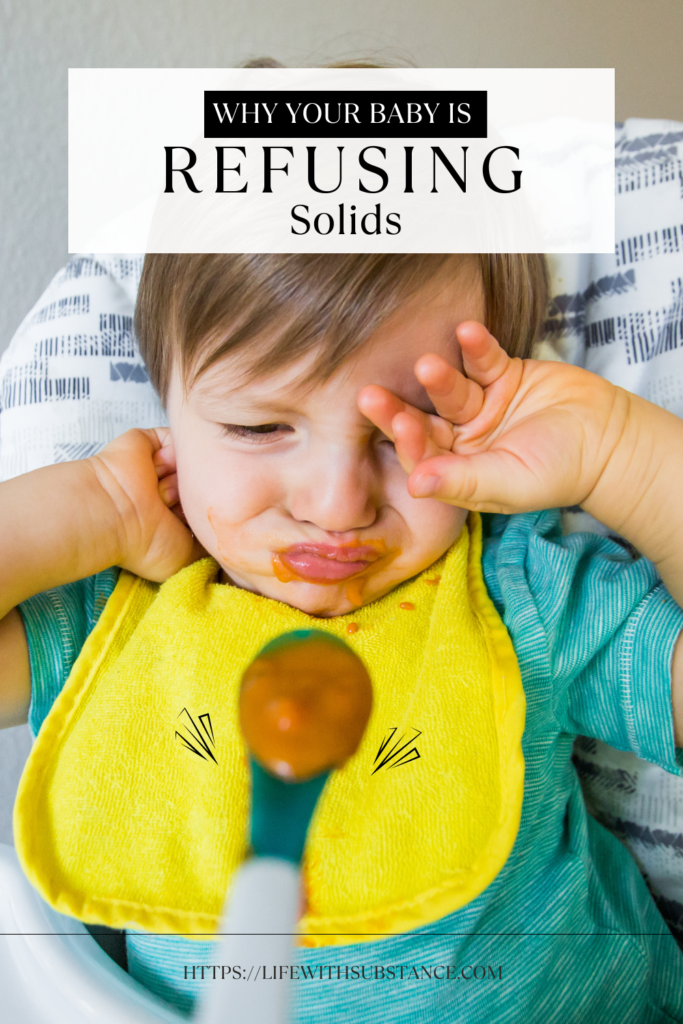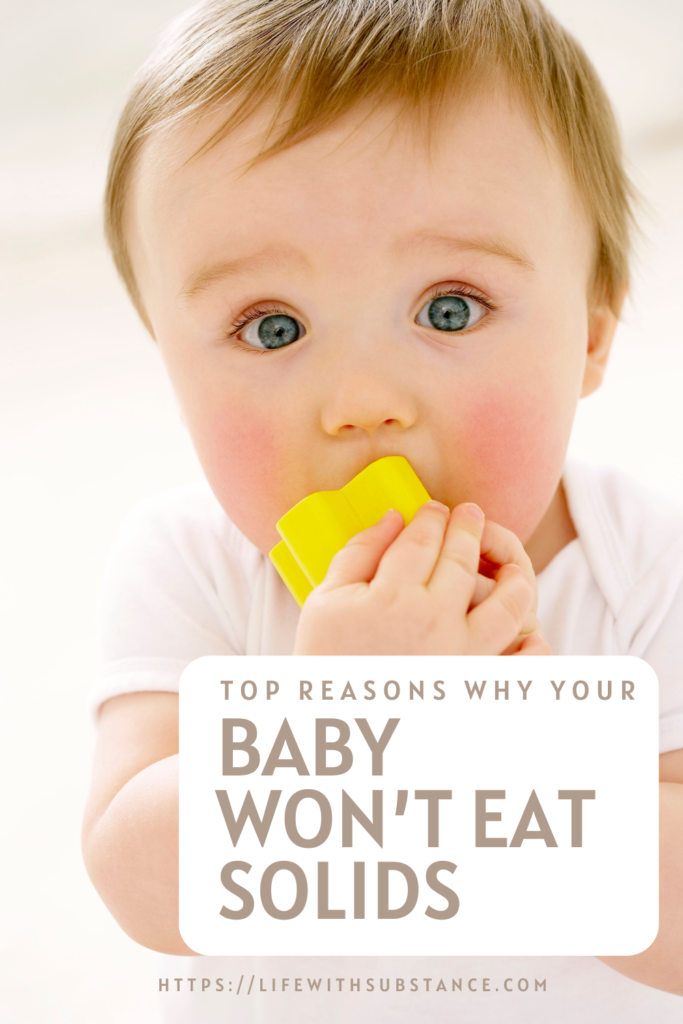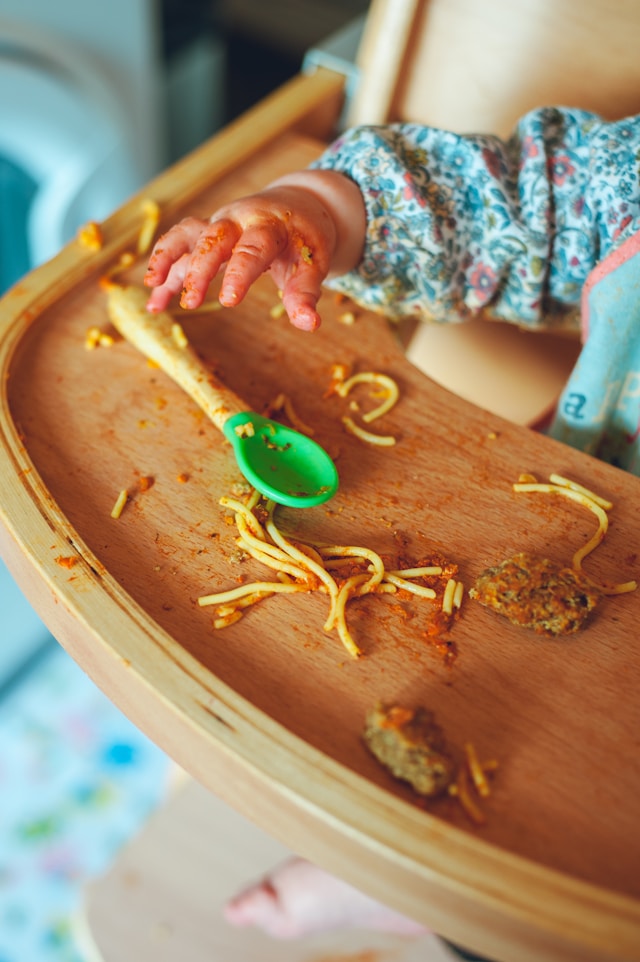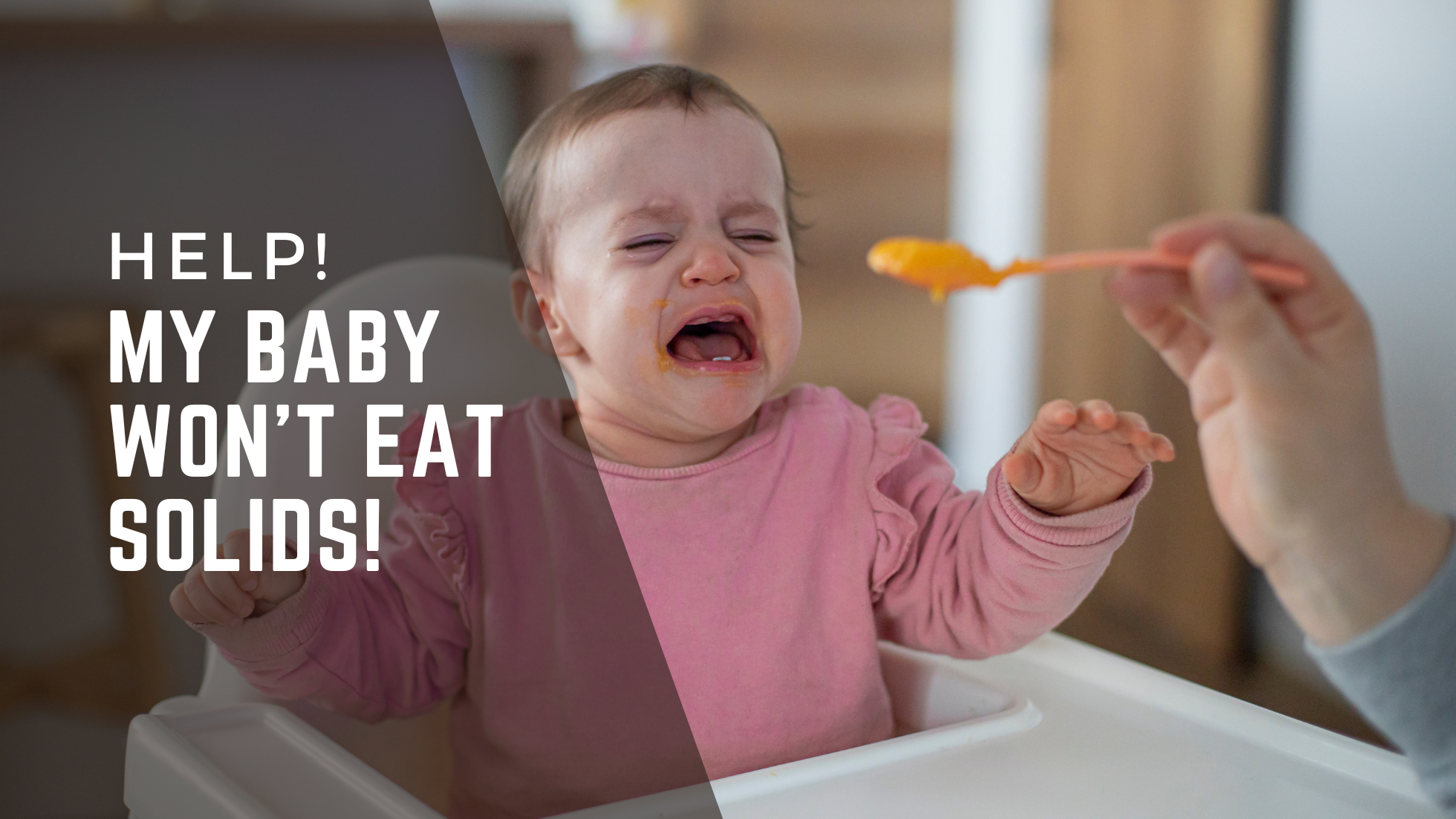This post may contain affiliate links. If you shop from one of our links, we may earn a commission.
I remember as a dietitian and new mom I was so excited to start feeding my daughter solids. And while I had a background in nutrition, I was not a pediatric specialist at the time and I felt nervous about navigating these new waters. I was fearful of “doing it wrong”. But what happened next was not at all what I was expecting.
My daughter had no interest in pureed food. I mean, don’t all babies love blended squash and green beans? This was when I quickly realized that there is not a textbook way to feed kids. While we assume every child will enjoy the introduction to solids and happily follow along with their growth chart, that’s not the story for every little one. So what do you do when your baby won’t eat solids?
When Your Baby Won’t Eat Solids
After only consuming breastmilk or infant formula for the first 6 months, the world of solids is a whole new experience. Some babies approach food with excitement and curiosity, while others purse their lips and turn up their noses. And then there are the ones that keep you on your toes and start off eating really well with a sudden refusal to eat. But here are some of the most common reasons to consider as to why your baby won’t eat solids.

Development
Some pediatricians suggest beginning solids at four months of age. However, many babies ages four to six months just aren’t developmentally ready to make that transition yet. A literature review was done in April 2001 on developmental readiness for normal full-term infants to advance from exclusive breast feeding to table food. What they found was:
- Babies exclusively breastfed for six months had greater immunologic protection
- A majority of normal full-term infants were not developmentally ready for solid foods until six to eight months
Signs of readiness to start solids include:
- Can sit upright with minimal support
- Able to hold his/her head/neck steady when sitting
- Opens their mouth when food is offered
- No longer demonstrates tongue-thrust reflex and automatically pushes solids out of his/her mouth
- Showing signs of a “pincer” grasp where they can pick up food or objects between thumb and forefinger
They’re Not Hungry
Initially, your baby relies solely on breast milk and/or formula. When you feel they are ready to transition to solids, remember that their tiny tummies only need a few tablespoons of food at a time for the first few weeks. The majority of their nutrition should come from milk/formula for when they are 6-8 months of age. Their appetite for solids will grow as they gradually wean off breast milk or formula.
Nursing or bottles can provide comfort for little ones, making it difficult to wean. As a result, your baby may be choosing to fill up on too much milk rather than transitioning to solids. Aim to find a balance by gradually reducing milk feeds while introducing small amounts of solids.
Consider spacing out meals and bottles/nursing to help stimulate your baby’s appetite. Make sure there are at least 30 minutes between milk and meals. You can even push this time frame out to 90 minutes to help them come to the table more ready to eat. Monitor for hunger cues. Due to rapid changes in growth and development at these stages, appetite can significantly vary from day to day. Try not to stress if they skip a meal here and there. The best indicator that they are getting adequate nutrition is that they are following along their growth curve.

They’re Adjusting to Sensory Changes
Babies often find the new sensory experiences that come with eating solids to be overwhelming. Different textures, flavors, and smells can be off-putting at first. If your baby shows reluctance, it’s likely due to this sensory overload. Start with smoother purees and gradually introduce lumpier textures to help them adjust. Offering small pieces of various foods can also make the transition easier.
Some kids (like my daughter) aren’t always a fan of pureed foods. As a result, some parents choose to follow a baby-led weaning method. Keep in mind, that each child is different. My first child preferred baby-led weaning, my second-born wanted a combination of spoon feeding with baby-led weaning, and my third child enjoyed spoon feeding with a gradual transition to solids.
It’s easy to get caught up in various feeding methods and pressures from friends or media. However, there is not a right or wrong way to do it. It’s more about paying attention to your baby and what works best for them.
Allowing your baby to explore these new sensations at their own pace and making mealtimes a relaxed experience can help them become more comfortable. Keep offering different foods and let your baby get hands-on with their meals to build familiarity and acceptance.
Illness or Discomfort
When babies are feeling under the weather, their appetite can take a significant hit. Conditions like a sore throat, ear infections, or gastrointestinal issues can make the act of eating uncomfortable or even painful. In these instances, food refusal is often a temporary response to their discomfort.
It’s crucial to be attentive to their overall health and look for signs of illness that might be impacting their eating habits. Soft, soothing foods may be more palatable during these times. If you notice persistent symptoms or ongoing food refusal, consulting a pediatrician for further guidance is advisable.
Teething
Teething can make your baby less eager to try solid foods due to the discomfort it causes. The pressure of chewing on tender gums can be painful, leading to food refusal. Offering chilled teething toys can help soothe their sore gums.
Soft foods, like mashed bananas or avocados, can be easier to manage and more appealing during this time. Frozen breast milk popsicles, frozen fruit in teethers, or frozen mango pits are also great soothing options to offer your little one during this phase.

Too Distracted
Babies can easily become distracted during mealtimes, which can lead to food refusal. The environment plays a significant role—TVs, loud noises, or too many toys can divert their attention from eating. Make sure your baby is seated comfortably in a high chair and minimize distractions by turning off the TV and keeping the dining area quiet. Sometimes, offering engaging but simple items, like a small spoon can help them stay interested in their meal without causing too much distraction.
Constipation
Starting solids can send your baby’s gastrointestinal tract through a rollercoaster of change with the introduction of new textures and important nutrients. You will also begin to see a change in the appearance of your child’s stools with the addition of solids foods. Constipation can make your baby uncomfortable, leading them to refuse solid foods. It can also suppress their appetite.
Signs of constipation include infrequent bowel movements, hard stools, or difficulty passing stools. To help ease their discomfort, consider introducing fiber-rich foods like pureed prunes, pears, or peas into their diet. Ensure they are getting enough fluids, as hydration is crucial for softening stools.
Gentle tummy massages and offering a warm bath can also provide relief. If the issue persists, seek professional help from your baby’s pediatrician to discuss further interventions and potential underlying causes.
Too Much Food Offered
It’s easy to have a skewed perception as to how much food is appropriate for such little bodies. As a result, the amount of food offered is too much. This can be overwhelming for babies just starting solids due to the variety of textures and new foods.
Instead, offer small portions of a familiar food along with a new food. The familiar food helps keep their interest in the meal and can encourage them to venture to try new foods. As always, monitor for hunger cues and offer more food as they desire.

How to Help Babies Accept Solids
While there are many variables that can impact your baby’s willingness to eat, there are several things you can do to help encourage intake.
Use a Responsive Feeding Method
As a pediatric dietitian, I recommend using a responsive feeding style with infants. Responsive feeding is a compassionate approach that respects your baby’s cues of hunger and fullness. Instead of following a strict schedule, offer solid foods when your baby shows signs of interest, such as reaching for food or opening their mouth. Allow them to explore and interact with the food at their own pace, fostering a positive experience.
This method encourages a healthy relationship with food, helping them become more confident eaters. Remember, it’s about being in tune with your baby’s needs and responding in a way that supports their natural development and curiosity.
Role Model
Monkey see, monkey do. Babies are constantly watching others and then are attempting to mimic their actions. This can be particularly helpful in the realm of feeding and eating. Exaggerate your enthusiasm around foods and create a positive environment around meal and snack times. When your baby sees you happily trying new tastes, it encourages them to follow suit.
Increase Exposure
The saying “try, and try again” could not be more true than when it comes to feeding little ones. When your infant spits out the peas we quickly mark it off as an undesired food and avoid offering it again. However, did you know it takes 15+ exposures to a food before your child can really determine how they feel about it? If they didn’t like the food today, try again in a week and see what they think.
Let Your Baby Get Messy
I get it, it’s a pain to clean up spaghetti sauce in their hair (or the wall). However, letting your baby get messy during meals is an essential part of their sensory development and acceptance of solid foods. Encourage your little one to touch, squish, and even smear food around; these tactile experiences can help them become more comfortable with different textures. It’s all part of their learning process.
Consider purchasing a bib with good coverage. This bib is my absolute favorite! They lasted through all of my kids and rather than the plastic-covered ones that the food slides right off into their lap, this absorbs without leaking through. I also highly recommend a good mat to lay under their high chair for quick clean-up.

Increase Oral Sensory Input
Enhancing your baby’s comfort with solid foods can be achieved by boosting their oral sensory experiences. Introduce activities that encourage them to explore different textures with their mouth, such as teething rings or safe, soft chew toys. Incorporating varied sensory play, like letting them gnaw on a silicone spoon, can make new textures less intimidating. Gradually exposing your baby to these sensations helps build familiarity and confidence.
For a more interactive approach, you can engage them in games that involve blowing bubbles or making funny faces, which also stimulate their oral muscles. These playful methods can support their transition to enjoying a diverse range of solid foods.
Keep Meal Times Positive
Maintaining a positive and stress-free mealtime environment is key to minimizing food refusal. Focus on making mealtimes enjoyable and pressure-free. Offer praise and encouragement for any effort your baby makes, no matter how small. Avoid turning mealtimes into a battleground; instead, let your baby explore food at their own pace.
Use fun, colorful plates and utensils to create a playful atmosphere. Your calm and positive demeanor can help your baby feel more relaxed and open to trying new foods.
When to Worry About Your Baby Refusing to Eat Solids
While occasional food refusal is normal, certain signs may indicate a need for concern.

Food allergies or intolerance
If your child is having an allergic reaction such as difficulty breathing, rash, vomiting, or diarrhea, consult your pediatrician for further evaluation.
Difficulty with tongue and jaw coordination
Occasional gagging (not choking) can be normal in the beginning stages of your baby learning to move food around in their mouth. However, excessive gagging or choking episodes warrant a visit to the doctor and speech therapist.
Excessive sensitivity to new sensory information
Some babies tend to be particularly sensitive to minimal amounts of sensory input such as light, sound, and touch. In these instances, your child may have a negative association with eating due to the mess and variety of textures.
A pediatrician can help identify any underlying problems and provide targeted support. It’s also essential to monitor your baby’s growth and overall health. If food refusal impacts their nutrition or development, timely intervention can make a significant difference. Don’t hesitate to reach out for help if you have ongoing worries about your child’s eating habits.
What Do When My Baby Refuses Solids Suddenly
Your baby’s refusal to eat when they have just been enjoying solids can feel alarming. However, a lot can change in a week or two (such as teething, growth spurt, etc). But there are also a few reasons why your baby may suddenly have a lack of interest in eating.
Are They Battling an Illness or Teething?
Colds, ear infections, or sprouting new teeth can be enough to refuse solids. If your little one doesn’t return to enjoying foods after these issues have been resolved, try the tips discussed above to help increase their interest in eating again.
They’ve Outgrown Purees
If your child started off spoon-feeding with smooth purees and suddenly has a decreased interest in eating, they may be bored and ready to move on to more challenging foods. Assess your child’s development and readiness to advance to more advanced textures (such as lumpy food or finger foods) while you pay close attention to their ability to manage the food.
They Want to Self-Feed
Babies love having a little independence. If you have noticed them reaching for the spoon or turning their head when being fed, they may want to try feeding themselves. Try pre-loading spoons initially while they are learning to self-feed. Consider offering your baby finger foods at other meals to challenge their fine motor skills.
In Conclusion
Feeding little ones can feel like an emotional roller coaster at times. Your baby may struggle with solids at various times for different reasons, however, small shifts in your feeding style can help get them back on track. Every baby is different in how quickly they choose to advance and their preferences. Keep being patient, positive, and a good role model.
Want 1:1 individualized feeding support? Sign up for a consultation today!



1 comment
Rattling good visual appeal on this internet site, I’d rate it 10 10.
Comments are closed.